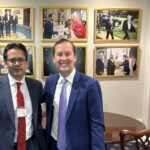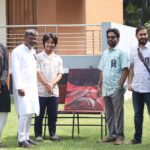 MOON Desk: An exhibition in London, hosted by the Saudi Embassy in the UK, is celebrating the late 19th and early 20th century expeditions of British women in the Arabian Peninsula.
MOON Desk: An exhibition in London, hosted by the Saudi Embassy in the UK, is celebrating the late 19th and early 20th century expeditions of British women in the Arabian Peninsula.
The “Early Women Explorers in Arabia” exhibition kicked off on Feb. 8 with a screening of a short film about English Princess Alice’s adventures as the first European royal to visit Arabia.
The film featured archival footage of her visit to Saudi Arabia in 1938 after receiving an impromptu invitation from Crown Prince Saud at the Ascot Racecourse.
The princess, who was the only European royal to meet King Abdulaziz, traveled the hills around Taif, through the desert to Riyadh, and east to Hofuf before arriving on the coast at Damman where oil had just been discovered in commercial quantities.
The exhibition launch also included a presentation by Dr. Elisabeth Kendall, explorer and mistress of Girton College Cambridge.
Kendall talked about her time in the field, specifically in war-torn Yemen, where she researched the use of soft culture, such as poetry, by militant jihad groups to recruit members and garner acceptance in the community.
“I think exploration is the best way to discover for yourself that stereotypes are just that — stereotypes,” Kendall told Arab News.
“My own experiences traveling around the Arabian Peninsula were that I’ve never felt so welcome in such a hospitable place with people who were so warm and so giving,” she added.
Kendall was later joined on stage by Saudi explorer Reem Philby to discuss her recent 1,300-km expedition across Saudi Arabia. The journey sought to raise awareness of the Kingdom’s historical relationship with Britain, following in the footsteps of her grandfather, the legendary British explorer Abdullah Philby.
Reem explained that her main drive to begin exploring around 15 years ago was to be a Saudi who knows her own country.
She also hoped that the “Heart of Arabia” expedition would promote the idea of “journeying with purpose and stepping away from the electronics we’re surrounding ourselves with.”
She said: “Carrying out this recent journey made me aware of the challenges both my grandfather and these Victorian women faced — the harsh cold of the desert at night, the physical challenges of very different terrains, and the fear of the unknown. Our route was mapped and safe. Theirs very often wasn’t.”
The exhibition features several Victorian British women who had a strong influence in the region during the late 19th and early 20th centuries, including Lady Anne Blunt, who traveled in the region as far as Hail in the 1880s to 1890s, and Gertrude Bell, one of the most influential Western women in Arabia, known for archaeological explorations and for political influence as the only female agent in the region during and after the First World War.
Lady Zainab Cobbold, the first British-born Muslim woman to carry out the Hajj, and Freya Stark, a historian and writer who went to some of the most dangerous corners of Hadhramaut, were also notable.
“I think the exhibition is going to be really inspiring. What it says to everyone, but particularly to women, is that you can go to places and do things that you perhaps would only dream of,” Kendall said.
“If they can do it, so can we,” she added.
Saudi Ambassador to the UK Prince Khalid bin Bandar, who attended the exhibition launch, told Arab News: “We had an amazing turnout to celebrate five amazing women from history and two amazing women tonight, both of whom showed the best of what Britain is and what Saudi Arabia is.
“Exploration is an underplayed field, and we need more of it. Saudi Arabia is a huge country with a lot to see, and it was our pleasure to show people here tonight what they’re missing by not being there.”
The “Early Women Explorers in Arabia” exhibition will run until March 5 at the Royal Geographical Society.





